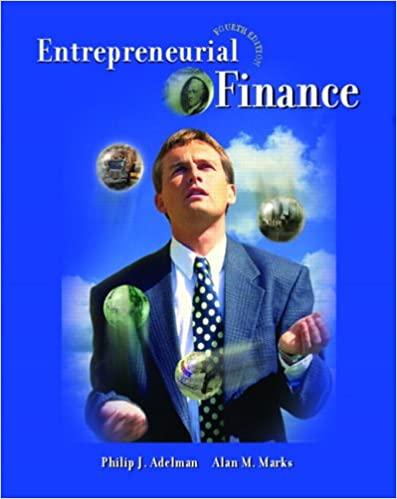Question
Which of the following statements is CORRECT? a. Well-diversified stockholders do not need to consider market risk when determining required rates of return. b. Market
Which of the following statements is CORRECT?
| |||
| |||
| |||
| |||
|
Wilson Co. is considering two mutually exclusive projects. Both require an initial investment of $9,100 at t = 0. Project X has an expected life of 2 years with after-tax cash inflows of $5,500 and $8,200 at the end of Years 1 and 2, respectively. In addition, Project X can be repeated at the end of Year 2 with no changes in its cash flows. Project Y has an expected life of 4 years with after-tax cash inflows of $4,800 at the end of each of the next 4 years. Each project has a WACC of 11%. What is the equivalent annual annuity of the most profitable project? Do not round intermediate calculations.
Rowell Company spent $3 million two years ago to build a plant for a new product. It then decided not to go forward with the project, so the building is available for sale or for a new product. Rowell owns the building free and clear - there is no mortgage on it. Which of the following statements is CORRECT?
Your company, CSUS Inc., is considering a new project whose data are shown below. The required equipment has a 3-year tax life. Under the new law, the equipment used in the project is eligible for 100% bonus depreciation, so the equipment will be fully depreciated at t = 0. The equipment has no salvage value at the end of the projects life, and the project does not require any additional operating working capital. Revenues and operating costs are expected to be constant over the project's 10-year expected operating life. What is the project's Year 4 cash flow?
| Equipment cost | $70,000 |
| Sales revenues, each year | $38,500 |
| Operating costs | $25,000 |
| Tax rate | 25.0% |
Your division is considering two projects with the following cash flows (in millions):
| 0 | 1 | 2 | 3 |
| Project A | -$17 | $8 | $8 | $3 |
| Project B | -$26 | $13 | $10 | $9 |
What are the projects' NPVs assuming the WACC is 5%? Enter your answer in millions. For example, an answer of $10,550,000 should be entered as 10.55. Negative values, if any, should be indicated by a minus sign. Do not round intermediate calculations. Round your answer to two decimal places.
Project A: $ million
Project B: $ million
What are the projects' NPVs assuming the WACC is 10%? Enter your answer in millions. For example, an answer of $10,550,000 should be entered as 10.55. Negative values, if any, should be indicated by a minus sign. Do not round intermediate calculations. Round your answer to two decimal places.
Project A: $ million
Project B: $ million
What are the projects' NPVs assuming the WACC is 15%? Enter your answer in millions. For example, an answer of $10,550,000 should be entered as 10.55. Negative values, if any, should be indicated by a minus sign. Do not round intermediate calculations. Round your answer to two decimal places.
Project A: $ million
Project B: $ million
What are the projects' IRRs assuming the WACC is 5%? Do not round intermediate calculations. Round your answer to two decimal places.
Project A: %
Project B: %
What are the projects' IRRs assuming the WACC is 10%? Do not round intermediate calculations. Round your answer to two decimal places.
Project A: %
Project B: %
What are the projects' IRRs assuming the WACC is 15%? Do not round intermediate calculations. Round your answer to two decimal places.
Project A: %
Project B: %
If the WACC was 5% and A and B were mutually exclusive, which project would you choose? (Hint: The crossover rate is 20.19%.)
-Select-Project AProject BNeither A nor BItem 13
If the WACC was 10% and A and B were mutually exclusive, which project would you choose? (Hint: The crossover rate is 20.19%.)
-Select-Project AProject BNeither A nor BItem 14
If the WACC was 15% and A and B were mutually exclusive, which project would you choose? (Hint: The crossover rate is 20.19%.)
-Select-Project AProject BNeither A nor B
Step by Step Solution
There are 3 Steps involved in it
Step: 1

Get Instant Access to Expert-Tailored Solutions
See step-by-step solutions with expert insights and AI powered tools for academic success
Step: 2

Step: 3

Ace Your Homework with AI
Get the answers you need in no time with our AI-driven, step-by-step assistance
Get Started


